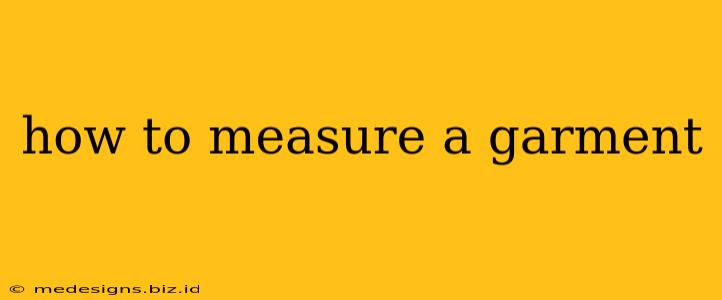Accurate garment measurements are crucial for a variety of reasons, from ensuring a proper fit when buying clothes online to creating custom-made garments. Whether you're a seasoned sewer, a savvy online shopper, or simply want to understand your own measurements better, this guide will walk you through the essential techniques for measuring garments accurately.
Essential Tools for Measuring Garments
Before you begin, gather the necessary tools. Having the right equipment ensures precision and consistent results. You'll need:
- A soft tape measure: Avoid using a rigid metal tape measure as it can distort the fabric and lead to inaccurate readings. A flexible tape measure that lies flat is ideal.
- A flat, stable surface: A large table or clean floor works well. Ensure the garment lies smoothly without wrinkles or creases.
- Pen and paper: To record your measurements.
- Seam ripper (optional): If you need to access seams for more accurate internal measurements.
Measuring Key Areas of a Garment
Different garments require different measurements. However, some key measurements are consistently important, regardless of the garment type.
1. Chest/Bust:
- Lay the garment flat: Place the garment on a flat surface, buttoned or zipped (if applicable).
- Measure across: Using your tape measure, measure across the widest part of the chest, from underarm to underarm. Double this measurement to get the full chest circumference.
2. Waist:
- Find the natural waistline: This is usually the narrowest part of the torso, above the navel.
- Measure around: Measure around the garment at the natural waistline.
3. Hips:
- Find the widest point: Locate the widest part of the garment across the hips. This is usually a few inches below the waist.
- Measure around: Measure around the garment at the widest part of the hips.
4. Length (Shoulder to Hem):
- Measure from the shoulder seam: Place the tape measure at the shoulder seam (where the shoulder meets the sleeve) and extend it to the bottom hem of the garment.
- Note: The length will vary depending on the garment style (e.g., dress, shirt, skirt).
5. Sleeve Length:
- Measure from the shoulder seam: Measure from the shoulder seam to the end of the sleeve cuff.
6. Shoulder Width:
- Measure across the back: Measure across the back of the garment, from one shoulder seam to the other.
Additional Measurements for Specific Garments
The above measurements are a good starting point. Depending on the type of garment, you may need additional measurements. For example:
- For pants: Inseam (from the crotch seam to the bottom hem), outseam (from the waist to the bottom hem), rise (from the crotch seam to the waistband).
- For dresses: Armhole circumference, neckline circumference, back length (from the base of the neck to the bottom hem).
- For skirts: Waist circumference, skirt length.
Tips for Accurate Measurements
- Take your time: Rushing can lead to errors. Take your time and ensure the garment is lying flat and the tape measure is snug but not pulling.
- Measure twice: It's always a good idea to double-check your measurements to ensure accuracy.
- Consider the fabric: The drape and stretch of the fabric can influence the final garment fit. Account for this when comparing measurements.
- Compare with a size chart: Once you have your measurements, refer to the size chart provided by the retailer or pattern instructions.
By following these steps, you can accurately measure garments and ensure you get the perfect fit, whether you're shopping online, sewing your own clothes, or simply trying to understand your clothing sizes better. Mastering garment measurement is a valuable skill for anyone interested in fashion, sewing, or simply buying clothes that fit perfectly.
